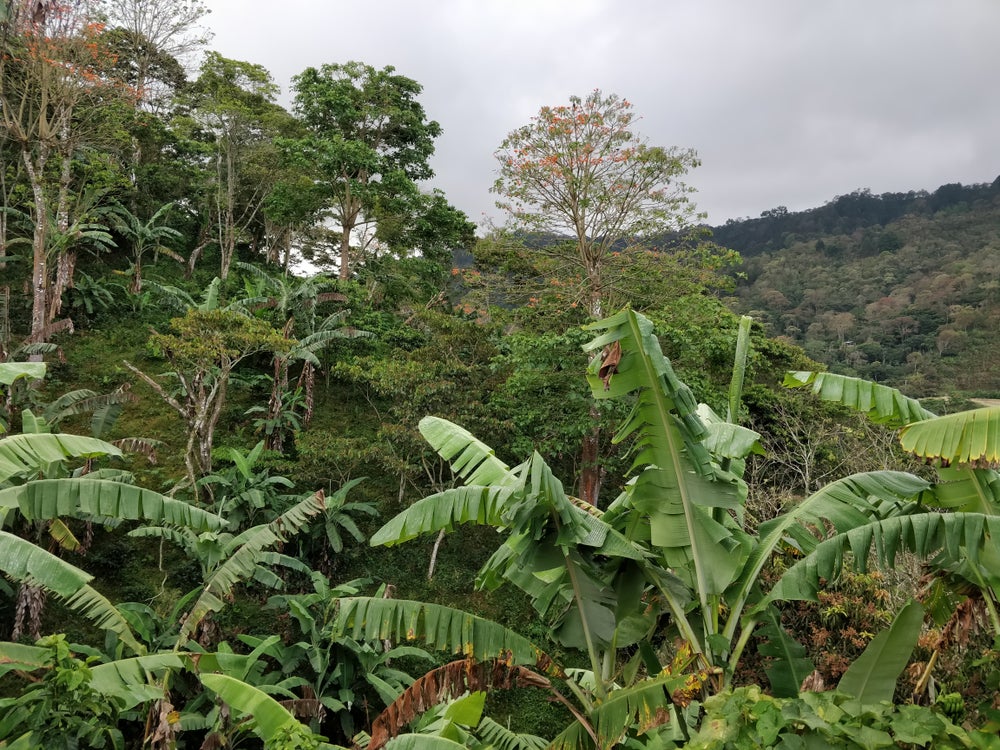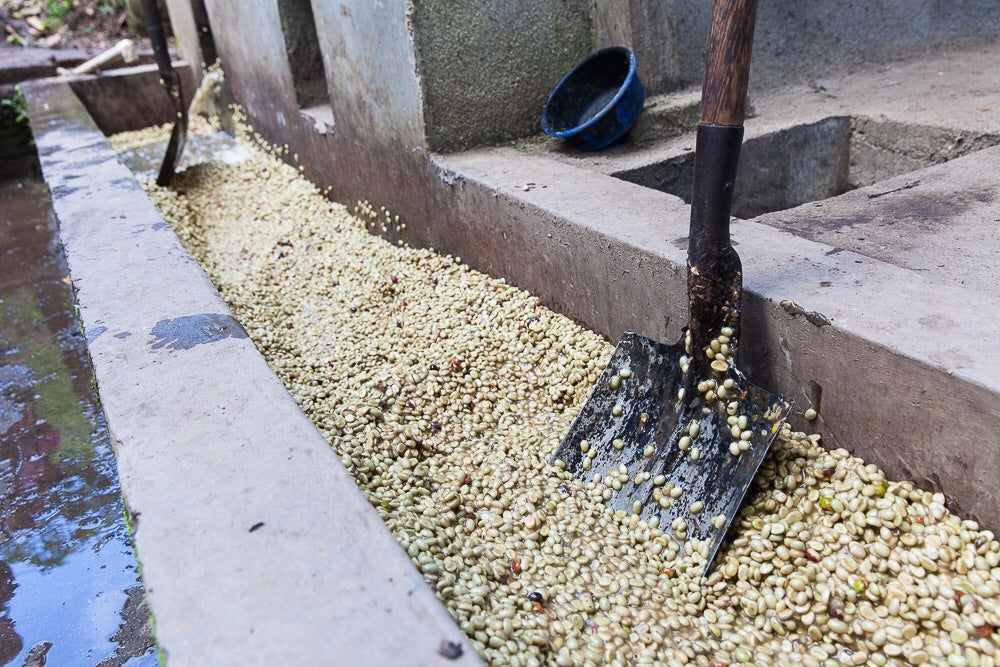

Nicaragua
Nicaragua may not be the most famous producer of Central American coffee, but it has great potential. The country is known as the land of ‘los lagos y los volcanes’ (lakes and volcanos) and has many coffee growing ‘pockets’ that few have heard of or experienced. Many producers in the country are experimenting with new varieties and processing methods, making it a specialty origin to watch.
Details
- Place In World Production:
- #12
- Average Annual Production:
- 2,650,000 (in 60kg bags)
- Common Arabica Varieties:
- Caturra, Bourbon, Maracaturra, Maragogype, Pacamara, Catuaí, Catimor
- Key Regions:
- Matagalpa | Jinotega | Estelí Madriz | Las Segovias
- Harvest Months:
- December - March
Offers
Before & After Coffee
Nicaragua's rich cultural history stretches back over 10,000 years before Europeans ever set foot on the soil in 1492. However, as in so many other Central American nations, coffee’s history in Nicaragua began when it arrived with colonialists in the mid-1800s. The first trees were planted on a mesa in the Pacific plains area of Nicaragua. Today, production is centralized in three areas within the country's Central northern mountains: Las Segovias, Matagalpa and Jinotega. All three areas are well known for their fertile volcanic soils, humid tropical forest climates and verdant eco-diversity including an array of groundcover such as lichens, moss and ferns.
Modern day Nicaragua depends on coffee as its primary export. Coffee production generates over $500 million dollars in exports annually and provides more than 200,000 jobs. Approximately 40,000 farmers and their families depend primarily on their income from coffee farming. These smaller farmers often cultivate coffee in semi-forested environments that can help preserve dwindling forests and at-risk species.
Political & Climatic Instability
The political instability and civil war in the last decades of the 20th century was a severe blow for the coffee industry in Nicaragua. Many coffee farms were abandoned during the Sandinista rule.
Compounding this, Hurricane Mitch hit Nicaragua in 1998, sweeping away much of the coffee infrastructure. The onslaught of the hurricane was followed by droughts that squeezed the economy even harder. When the country was still in recovery from 1999 to 2003, the coffee price crisis seized the global coffee industry. Low international prices meant farmers had barely enough to live on, much less to reinvest in their farms and continue to rebuild and improve their cultivation post- hurricane.
Nicaragua in Crisis
Since coffee plays such a big role in the country’s national development, the consequences of the crisis were disastrous for the already ravaged country. Three of the six largest national banks crashed because of high debts. Prices fell so low that it cost more in labor and time to harvest coffee than farmers were able to get from selling it. Cherry rotted on the trees while farmers lived off only intercropped fruits and vegetables.
As the second poorest country in the western hemisphere, Nicaragua simply did not have the resources to invest in recovery. Small-scale producers were hit the worst, because they did not have access to other sources of income. The crisis got so bad that plantation owners stopped paying their workers. Out of protest, hundreds of landless families who made their incomes harvesting cherry marched down from the coffee-producing lands to a major highway to Managua. They lived along the side of the highway in miserable conditions and survived on food donations for three years.
The rural workers’ union managed to win plots of land for the more than 3,000 landless workers in a historic agreement known as ‘El Acuerdo de las Tunas’.
The Growth of Cooperatives
Cooperatives played an important role in rebuilding Nicaragua’s coffee sector following the price crisis of the 1990s and early 2000s. In order to understand cooperative’s impact, it’s helpful to go back to the beginning and understand how cooperatives gained prominence in the country.
While a few cooperatives were formed in the early 1900s, the period of Somoza dictatorships that cooperatives helped foster more widespread cooperative membership. The Somoza family ruled as autocratic dictators from 1936 to 1979 and would periodically promote cooperatives for various political reasons. Nevertheless, cooperatives remained an afterthought in the country until the 1979 revolution brought the Sandinista government to power.
The Sandinistas ruled from 1980 to 1990 and during that decade, had a significant influence on the creation and expansion of many of the cooperatives active in Nicaragua today. Under the Sandinista government, land was reallocated—mainly from large or European landholders—to cooperatives, who were directed to redistribute the land to previously landless farm workers.
In the same period, the initial wave of Fairtrade and Organic coffee certifications began. The increasing demand for Fairtrade and Organic coffee became particularly important after the fall of the Sandinista government in 1990, when many cooperatives that had been supported by the government collapsed. Many cooperatives were able to stay afloat by gaining alternative support from ethical trade certifications or by merging into secondary level organizations and securing land titles. They were supported in these efforts by a number of NGOs working within the country at the time, such as Technoserve, who established cupping labs and training programs in the country.
The surviving cooperatives later played an integral role in helping members access technical assistance and emerging specialty coffee markets. Notably, while the number of cooperatives decreased due to the combined effects of cooperative mergers and dissolutions, membership actually increased by over 10% in the decade or so following the end of the Sandinista government.
From the 1990s to the present day, the remaining cooperatives in Nicaragua expanded in both size and scope. As specialty markets matured, many of these cooperatives have helped farmers navigate the changing coffee sector by building new processing infrastructure, supplying training, creating strong quality assurance programs and training full time cooperative staff to support their members. Cooperatives have grown beyond purely enhancing coffee quality and price and are now more focused on leveraging profits and social premiums to enact broader community improvements.
Many farmers didn’t have the resources to renovate entire farms at once, so it was a gradual renovation process, over the course of a few years, but they’ve slowly recovered to healthy national production levels.
Looking to the Future
Many coffee producers in Nicaragua today are buoyed by cooperatives that provide a wide array of services, supports and opportunity. As seen in the win of the ‘El Acuerdo de las Tunas’, where 3,000 landless workers won land rights, collective action by farmers can be far more effective at enacting widespread change than the advocacy of individual farmers.
Cooperatives and farmer associations in Nicaragua encompass a large percentage of the country’s coffee producers, and they are taking their destiny in their own hands. By putting great emphasis on quality and by aiming for the international specialty coffee industry, cooperatives and farmers associations are helping their members gain influence and import that will, hopefully, garner enough profit to enable farmers to continue to improve and invest in their farms and their families.
Large and medium-sized (10+ hectare) farms also hold a significant place in Nicaragua’s coffee landscape, as well. Many of these farms have also prioritized social and environmental issues and are working on quality improvements at both cultivation and post-harvest levels.
Post-harvest Practices
Nicaragua is one of the least densely populated countries in Central America, meaning that one of the primary resources available to Nicaraguan coffee producers is also one of the most important: land. Farmers, for the most part, will process coffee on their own farms, and the majority of the time coffee is dried on large drying patios under sun.
Smallholder farmers have benefited greatly from increased post-harvest training, frequently accessed through cooperatives. Milling infrastructure has improved their ability to sell under their own name, and thus hold onto any quality premiums attached to specialty production
Until recently, farmers were unable to sell their coffees to international buyers as traceable single estate lots because the only dry mills that could prepare coffee for export were large and had large minimum lot requirements. If they wanted to export their coffee, farmers were required to combine their lots with other farms and varieties in order to meet the minimum bag count to get their parchment dry milled. Now, farmer associations and cooperatives are investing in their own infrastructure that will enable them to maintain single-lot and single-farm traceability from farmer to exporter.